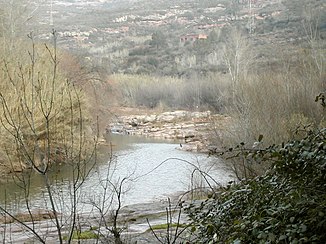Llobregat
| Riu Llobregat | ||
|
Río Llobregat |
||
| Data | ||
| location | Spain | |
| River system | Llobregat | |
| source | near Castellar de n'Hug in the Comarca Berguedà 42 ° 17 ′ 2 ″ N , 2 ° 0 ′ 56 ″ E |
|
| Source height | 1295 msnm | |
| muzzle | to the Mediterranean Coordinates: 41 ° 17 ′ 55 " N , 2 ° 8 ′ 15" E 41 ° 17 ′ 55 " N , 2 ° 8 ′ 15" E |
|
| Mouth height | 0 msnm | |
| Height difference | 1295 m | |
| Bottom slope | approx. 7.6 ‰ | |
| length | approx. 170 km | |
| Catchment area | approx. 4950 km² | |
| Medium-sized cities | Monistrol , San Feliu de Llobregat , L'Hospitalet de Llobregat | |

The Riu Llobregat [ ʎuβɾəˈɣat ] is the second longest river in Catalonia after the Ter .
course
The Riu Llobregat rises about 25 kilometers northeast of the city of Berga in the eastern Pyrenees from two spring streams - which do not carry water all year round - at an altitude of about 1295 meters above sea level. d. The river is dammed into a lake south of La Pobla de Lillet .
In the further course, which always leads south, it flows through the places Gironella , Sallent de Llobregat , Monistrol de Montserrat , Martorell and Sant Feliu de Llobregat , before then after approx. 170 kilometers with a small river delta between El Prat de Llobregat and Barcelona - where it forms the municipal boundary between the two places - flows into the Mediterranean .
Tributaries
The most important tributaries are the Cardener (near Manresa ) and the Anoia (near Martorell).
history
The Llobregat is already mentioned in the ancient sources. Pliny the Elder calls it in Naturalis Historia flumen Rubricatus , which flows in the Ilergetum ( Lleida ) region . Claudius Ptolemy specifies in his Geographike Hyphegesis that it flows into the sea between Badalona ( Βαιτουλῶν ) and Barcelona ( Βαρκινών ). The name Rubricatus , from which Llobregat comes, means something like 'colored red'. The lenization of the / k / to / ɣ / is a typical feature of the Western Romance languages, the change from / ɾ / to / ʎ / falls under the phenomenon of lambdazism .
In the course of the industrial revolution , industries that use the river's hydropower settled on the Llobregat . The textile industry , for example, should be emphasized . The potash significantly increases the salt concentration of the Llobregats and represents a threat to biodiversity . The EU Commission has launched legal action against Spain in January 2018 as the Directive 2000/60 / EC (Water Framework Directive) is not met.
economy
Due to the large gradient in the upper and middle reaches, the Llobregat was attractive for industrial settlements. The specific form of the "colonies" (textile factory, settlement with trade, culture and education, etc.) in an isolated location directly above the river has developed, some of which are close to one another. The best known is probably the Colònia Güell , which is of interest because of its architectural style and buildings by Antoni Gaudí .
Attractions
In Martorell, the river is spanned by the impressive late medieval Devil's Bridge, which is on the route of the Roman Via Augusta , as indicated by an archway built from large hewn ashlar blocks on the north side, which probably marked the beginning or the end of an ancient previous building.
literature
- S. Sabater & A. Ginebreda & D. Barceló (Eds.): The Llobregat: The Story of a Polluted Mediterranean River. Springer, 2012. ISBN 978-3-642-30938-0
Web links
Individual evidence
- ↑ Ruben Ladrera, Miguel Cañedo-Argüelles, Narcis Prat: Impact of potash mining in streams: the Llobregat basin (northeast Spain) as a case study. In: Journal of Limnology. 2015, doi : 10.4081 / jlimnol.2016.1525 .
- ↑ Brussels urges implementation of EU water law in Ireland, Spain, Sweden and Poland. In: euwid-wasser.de. January 26, 2018, accessed December 10, 2018 .
